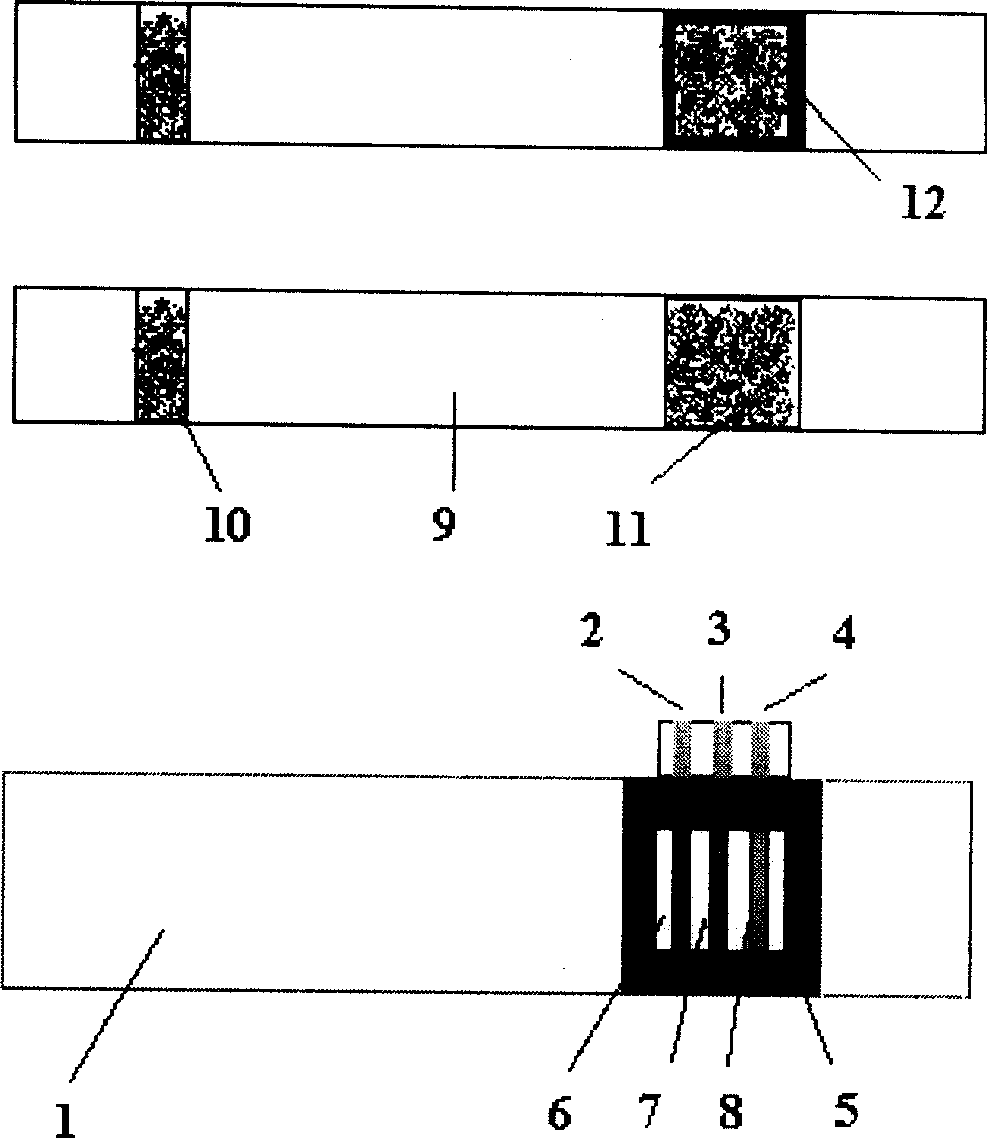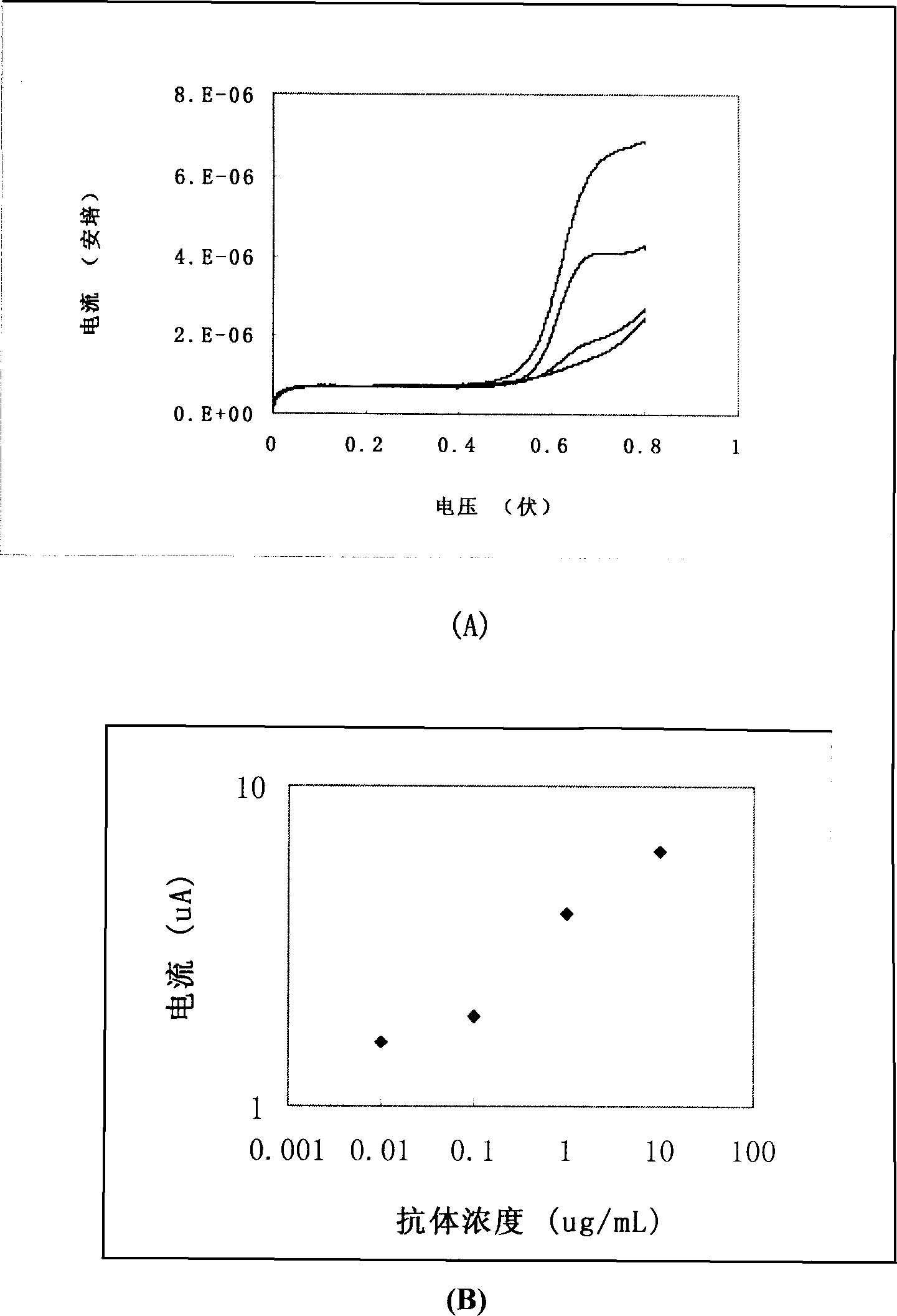Paper strip for quantitative electrochemical biological test
A quantitative detection and test strip technology, which is applied in biological testing, material electrochemical variables, microbial measurement/inspection, etc., can solve the problems of limited immobilization of biomolecules and affecting detection sensitivity, etc.
- Summary
- Abstract
- Description
- Claims
- Application Information
AI Technical Summary
Problems solved by technology
Method used
Image
Examples
Embodiment 1
[0016] Example 1: Electrochemical method to detect the immune reaction between mouse IgG / goat anti-mouse IgG on nitrocellulose membrane.
[0017] Take a square nitrocellulose membrane with a side length of 1 cm and soak it overnight in 10 μg / mL mouse IgG (dissolved in 20 mM sodium carbonate / sodium bicarbonate buffer, pH 9.5). After washing, block with 1% BSA for 2 hours. Add different concentrations of alkaline phosphatase-labeled goat anti-mouse antibody, and shake at room temperature for 1 hour. After cleaning, the membrane was placed on the screen-printed electrode sheet and phosphate phenol was added. After waiting for 5 minutes, start the cyclic voltammetry detection program of the electrochemical workstation, and record the current signal. get as figure 2 The results shown show that the detected current signal has a linear relationship with the concentration of the enzyme-labeled antibody within a certain range, and the lowest level of 0.1 μg / mL (0.7nM) antibody can ...
Embodiment 2
[0018] Example 2: Electrochemical method for detection of immune reaction between estradiol antigen / antibody on nitrocellulose membrane.
[0019] Take a square nitrocellulose membrane with a side length of 1 cm and soak it overnight in 10 μg / mL estradiol antigen (dissolved in 20 mM sodium carbonate / sodium bicarbonate buffer, pH 9.5). After washing, block with 1% BSA for 1 hour. Different concentrations of estradiol mouse monoclonal antibody were added, and the reaction was shaken at room temperature for 1 hour. After washing, add alkaline phosphatase-labeled goat anti-mouse secondary antibody diluted 1000 times and react with shaking at room temperature for 1 hour. After cleaning, the membrane was placed on the screen-printed electrode sheet and phosphate phenol was added. After waiting for 5 minutes, start the cyclic voltammetry detection program of the electrochemical workstation, and record the current signal. get as image 3 The results shown indicate that the detected...
Embodiment 3
[0020] Example 3: Electrochemical method to detect the competitive immune response of estradiol on nitrocellulose membrane.
[0021] Take a square nitrocellulose membrane with a side length of 1 cm and soak it overnight in 10 μg / mL estradiol antigen (dissolved in 20 mM sodium carbonate / sodium bicarbonate buffer, pH 9.5). After washing, block with 1% BSA for 1 hour. Add different concentrations of estradiol and 0.1 μg / mL estradiol mouse monoclonal antibody, and shake at room temperature for 1 hour. After washing, add alkaline phosphatase-labeled goat anti-mouse secondary antibody diluted 1000 times and react with shaking at room temperature for 1 hour. After cleaning, the membrane was placed on the screen-printed electrode sheet and phosphate phenol was added. After waiting for 5 minutes, start the cyclic voltammetry detection program of the electrochemical workstation, and record the current signal. get as Figure 4 The results shown indicate that the detected current sign...
PUM
 Login to View More
Login to View More Abstract
Description
Claims
Application Information
 Login to View More
Login to View More - Generate Ideas
- Intellectual Property
- Life Sciences
- Materials
- Tech Scout
- Unparalleled Data Quality
- Higher Quality Content
- 60% Fewer Hallucinations
Browse by: Latest US Patents, China's latest patents, Technical Efficacy Thesaurus, Application Domain, Technology Topic, Popular Technical Reports.
© 2025 PatSnap. All rights reserved.Legal|Privacy policy|Modern Slavery Act Transparency Statement|Sitemap|About US| Contact US: help@patsnap.com



